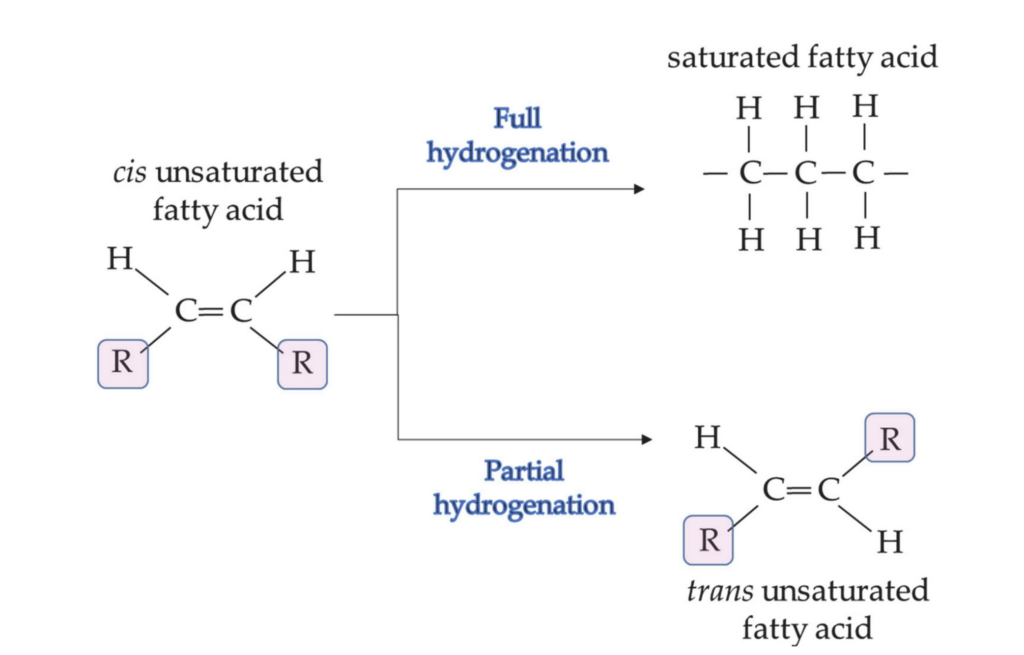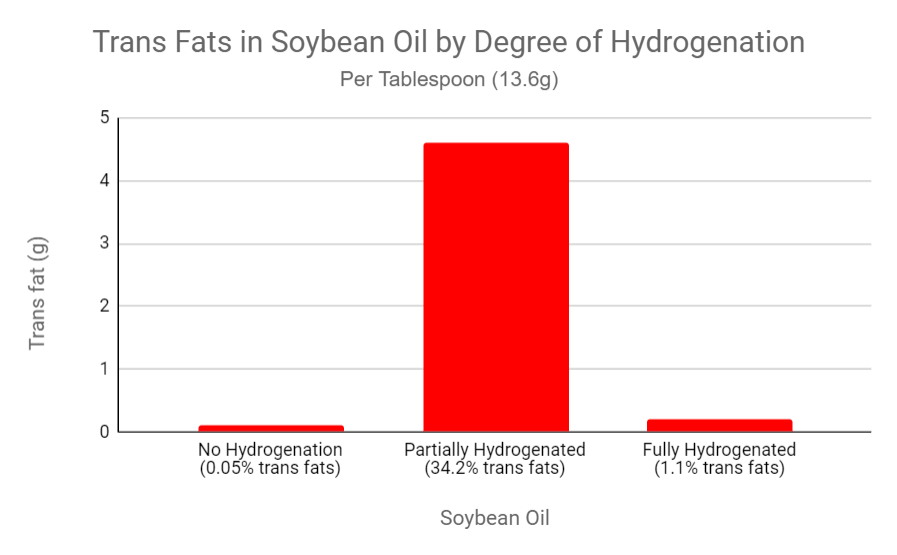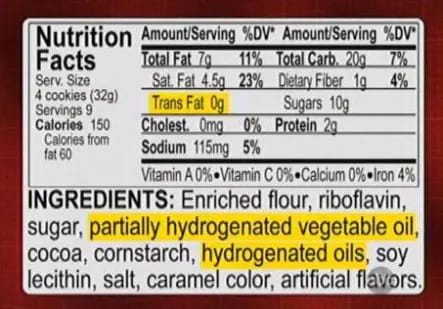
Fats are an essential part of our diet, but not all fats are created equal. You might have come across terms like “hydrogenated” or “partially hydrogenated” fats on food labels and wondered, “What does that mean for my health?”
These are processed fats created to improve the texture and shelf life of foods, but they come with their own set of health concerns. Let’s break it down in a simple way so you can make healthier choices.
What Are Hydrogenated and Partially Hydrogenated Fats?
Hydrogenation is a chemical process in which hydrogen is added to liquid vegetable oils, turning them into solid or semi-solid fats. This transformation provides stability, prolongs shelf life, and improves food texture.
Fully Hydrogenated Fats
Fully hydrogenated fats are fats that have undergone a complete hydrogenation process, transforming liquid oils into solid fats at room temperature. This process changes the structure of unsaturated fatty acids in the oil, turning them into saturated fats.
The solid consistency makes fully hydrogenated fats ideal for use in products that need a stable, longer shelf life and solid texture. Examples include shortening and certain types of margarine.
Partially Hydrogenated Fats
Partially hydrogenated fats have only gone through a partial hydrogenation process, meaning they are not fully saturated. This leaves them softer and more spreadable than fully hydrogenated fats.
Partially hydrogenated fats are semi-solid at room temperature and offer a creamy or smooth texture, which is useful in products like spreads, some baked goods, and certain snack foods. This texture improves consistency and extends the shelf life of these foods without making them fully solid.

Fatty Acid Composition
Fully Hydrogenated Fats:
When oils are fully hydrogenated, they undergo a complete transformation, converting all unsaturated fatty acids into saturated fatty acids.
Fully hydrogenated fats are typically solid at room temperature because they are predominantly composed of saturated fats. These fats contain little to no trans fats because the hydrogenation process is complete, converting all the double bonds in unsaturated fats into single bonds, resulting in a fully saturated structure.
Partially Hydrogenated Fats:
In partially hydrogenated fats, the hydrogenation process is not complete. This partial transformation leaves some double bonds in their original state, resulting in the creation of trans fatty acids.
Trans fats are a byproduct of partial hydrogenation, as some of the remaining double bonds in unsaturated fats are reconfigured into a trans configuration rather than a cis configuration. This partial hydrogenation makes the oils semi-solid at room temperature, providing a desirable creamy or spreadable consistency often used in processed foods.

Which One Is More Harmful?
Partially Hydrogenated Fats
In partially hydrogenated fats, some of the unsaturated fats are transformed into trans fats. Trans fats are rare in nature and only occur in trace amounts in animal products, but partial hydrogenation introduces them in significant quantities in processed foods. Trans fats can raise LDL-cholesterol levels and lower the HDL-cholesterol levels, which increases the risk of heart disease.
The presence of trans fats in partially hydrogenated fats and food products is likely to lead many individuals to surpass their recommended maximum intake. The Institute of Medicine concluded that no safe level of industrial trans fats ingestion from partially hydrogenated fats exists.
In 2015, the US Food and Drug Administration determined that partially hydrogenated fats are not Generally Recognized as Safe (GRAS) and must be eliminated from the food supply.
Fully Hydrogenated Fats
Fully hydrogenated fats, such as those found in shortening or hard margarines, contain more saturated fats, which are solid at room temperature. Unlike trans fats, saturated fats do not have as strong a negative health impact when consumed in moderate amounts, though excessive intake is associated with elevated LDL-cholesterol levels.
General Recommendations for Saturated Fats (SFA) and Trans Fats Intake:
Saturated Fats (SFA): Less than 10% of total daily calories.
Trans Fats: Less than 1% of total daily calories.
Common Foods That May Contain Partially Hydrogenated Fats
Partially hydrogenated fats are commonly found in a variety of processed foods, especially those that require a longer shelf life, a certain texture, or a creamy consistency. Here are some common types of products that may contain partially hydrogenated fats:
a) Baked Products: Many commercially produced cakes, cookies, pastries, donuts, and pie crusts often contain partially hydrogenated fats to maintain a soft or flaky texture and to extend shelf life.
b) Snack Foods: Chips, crackers, microwave popcorn, and other snack items frequently use partially hydrogenated fats to achieve a crunchy texture and longer freshness.
c) Fried Foods: Many fast food items and frozen fried foods (like French fries, chicken nuggets, and onion rings) may contain partially hydrogenated fats for a crispier finish and to withstand high frying temperatures.
d) Margarine and Shortening: These products often contain partially hydrogenated fats to keep a spreadable consistency at room temperature. Shortening is commonly used in baking and cooking.
e) Non-Dairy Creamers and Coffee Creamers: Partially hydrogenated fats are often used in non-dairy creamers to create a creamy texture without dairy.
f) Ready-to-Eat Frostings and Icings: Pre-packaged frostings and icings may contain partially hydrogenated fats to maintain texture and stability.
g) Packaged Dough and Refrigerated Biscuits: Pre-made dough, such as canned biscuits, croissants, and pizza dough, may contain partially hydrogenated fats to improve texture and shelf stability.
h) Processed Cheese Products: Some processed cheese spreads and slices may contain partially hydrogenated fats to improve consistency and shelf life.
What Can You Do?
If you’re just starting on your health journey, one simple tip is to read ingredient labels. Look for “partially hydrogenated fats” and avoid foods that contain them. Instead, opt for products with natural oils or have oils other than “partially hydrogenated fats” and adjust its dosage according to your daily needs.
Regulations and Progress in India
India has made strides in regulating trans fats under FSSAI (Food Safety and Standards Authority of India) guidelines. In 2022, the country aimed to reduce trans fats in industrial food products to less than 2%. These measures align with the World Health Organization’s goal of eliminating trans fats globally.
However, awareness among consumers remains limited. Reading ingredient labels and avoiding “partially hydrogenated fats” can significantly reduce trans fat intake.

Conclusion
In conclusion, always check the ingredient label on food packaging to ensure it does not contain partially hydrogenated fats. These fats can increase your intake of trans fats, which, with regular consumption, can pose serious risks to your heart health.
Long-term intake of trans fats has been linked to an increased risk of heart disease, so choosing products without partially hydrogenated fats is a step toward protecting your health.
References:
Patterson, H. B. W. “Hydrogenation methods.” Hydrogenation of fats and oils. AOCS Press, 2011. 189-278.
Tailoring the Structure of Lipids, Oleogels and Fat Replacers by Different Approaches for Solving the Trans-Fat Issue—A Review – https://www.researchgate.net/publication/352404141_Tailoring_the_Structure_of_Lipids_Oleogels_and_Fat_Replacers_by_Different_Approaches_for_Solving_the_Trans-Fat_Issue-A_Review
https://fssai.gov.in/upload/uploadfiles/files/Regulation_of_TFA.pdf
Liu, Ann G., et al. “A healthy approach to dietary fats: understanding the science and taking action to reduce consumer confusion.” Nutrition journal 16 (2017): 1-15.
Mozaffarian, Dariush, et al. “Trans fatty acids and cardiovascular disease.” New England Journal of Medicine 354.15 (2006): 1601-1613.
(PDF) Commercially available alternatives to palm oil – https://www.researchgate.net/publication/301316201_Commercially_available_alternatives_to_palm_oil
Dietary Fats and Cardiovascular Disease: A Presidential Advisory From the American Heart Association – https://www.ahajournals.org/doi/10.1161/cir.0000000000000510